Pushkar, Rajasthan, India: Feb 2024
RELATIONSHIT
If you ever want to find out the hard way if a relationship is right for you, try travelling around India with them for a month, ending in a 10-day silent retreat. Let me know how that works out for you. It’d be good to compare notes.
“I can’t wait for 10 days without you,” he snapped, stormily shoving his sleeping bag into a bag in the guesthouse in Pushkar as we were getting ready to leave for the meditation centre. Ah, beautiful, romance is not dead.
After a month of intense travel through India, we were exhausted and irritable with each other. I even found myself googling, what is a toxic relationship? I mean, if you have to look that up, things aren’t exactly all champagne and strawberries, are they?
We signed up to 10 days of silence – no speaking, no devices, no writing, no eye contact, no gestures. Nothing but meditation, sleep, light meals and pacing back and forth on a path for exercise. Just you and your thoughts, stewing away in a casserole of your own shit. I wasn’t sure if it was a savvy step or just pure lunacy to sit a Vipassana carrying the weight of relationshittiness. Will I drive myself completely bonkers with my own thoughts?
WHAT IS VIPASSANA ANYWAY?
The word Vipassana roughly translates from the ancient Pali language to “seeing things as they really are”. It’s about not reacting to what life throws at you with craving (I like this! Gimme more!) or aversion (I don’t like this! No more please!).
It’s all about equanimity, responding with a neutral acceptance, with even-mindedness. It’s about impermanence (anicca), knowing that all moments shall pass, whether good or bad, even though we want the good stuff to stick around and the bad stuff to be done. Vipassana is an arse-kicking lesson in non-reactivity that couldn’t have come at a better time, or a worse time, depending on how you look at it.
The Vipassana meditation technique is ancient but really got its big break thanks to the wonderful S.N. Goenka. He was born in Myanmar to Indian parents, and it was there that he met meditation teacher Sayagyi U Ba Khin, who introduced him to the magic of Vipassana. After studying with him for 14 years, he then moved to India to begin teaching it himself. He led countless meditation retreats in India and worldwide, and in 1982 he began appointing assistant teachers to help him reach more people.
Vipassana has its roots in Buddhism, but it’s not about a religious practice. The Buddha didn’t teach a religion; he taught a path to freedom, or Dhamma, which is exactly what makes Vipassana so universal.
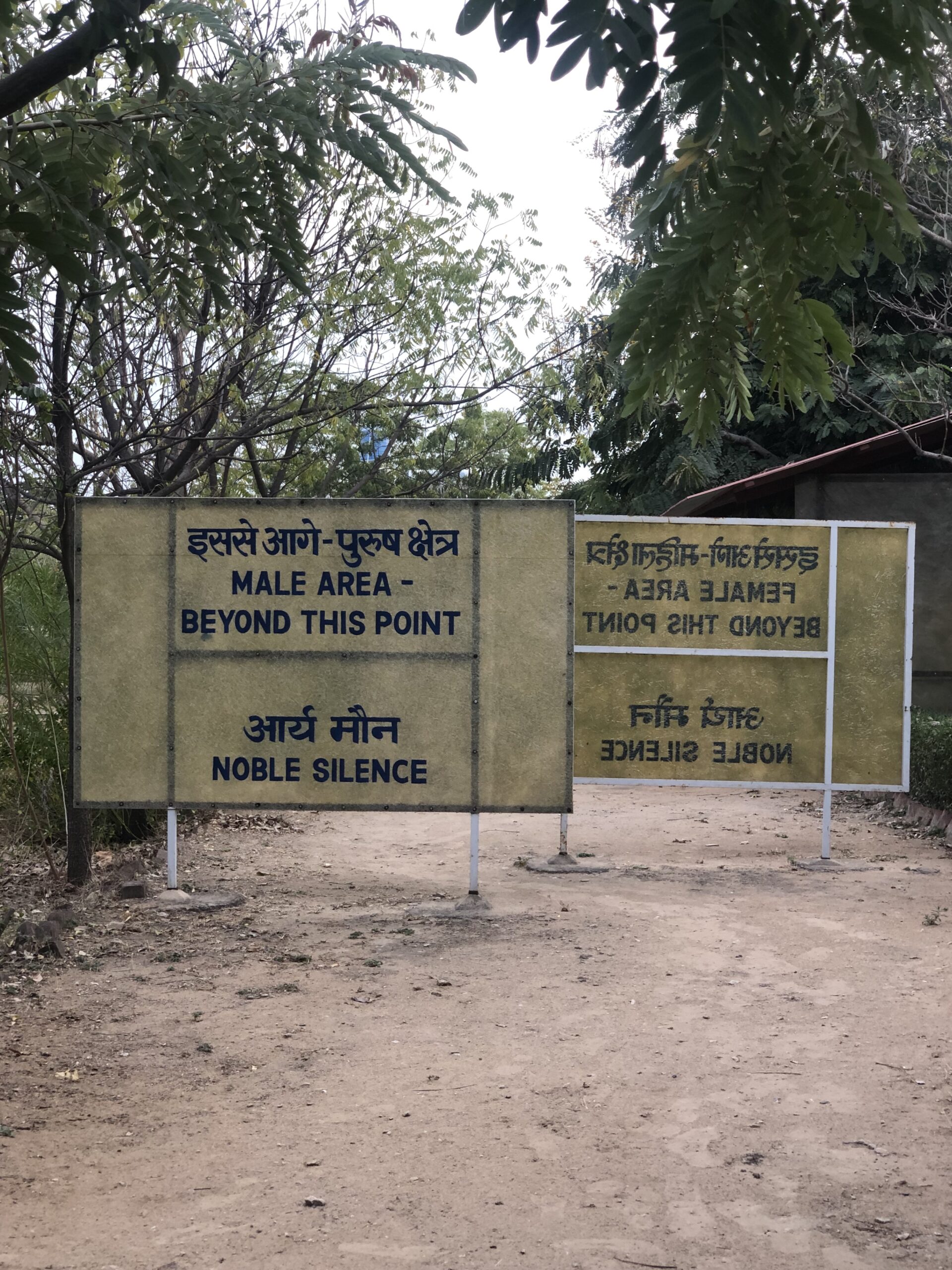
MEETING MY ROOMMATE: ENTER PARISIAN LOUISE
We arrived at 2pm and had time to settle in, with the silence due to kick off at 7pm. The male and female residential quarters were totally segregated by a tall barbed wire fence. We hugged, wished each other well. I went to my room and laid out my sleeping bag, got somewhat settled in the spartan room I was to share with another participant. We made use of the time to chitchat. At that point, I was the only foreigner among 18 Indian ladies, and we were fascinated by each other. Why you no marry? Why you no children? All the usual gasps and wows.
As the afternoon passed, I started feeling hopeful that I was going to have a room to myself, but I was also aware that awkward room-sharing is part of the full Vipassana experience of getting along with discomfort. It was almost 7pm and I was just about to leave for the first session in the meditation hall, when someone burst through the bedroom door, all suitcases and smiles, “HIIII!”
There was no time to get to know each other, and all l I found out about her was that she’s Louise from Paris, and that she seems like a decent, friendly sort. I spent the next 10 days speculating about her Parisian life, concocting scenarios in which she stood in a boardroom pitching revolutionary skincare products.

INTO THE DHAMMA HALL
Twenty women and eighty men sat cross-legged on the floor of the main room, the Dhamma Hall. There was a female teacher and a male teacher sitting up on a platform before us. We were to sit in meditation for about 11 hours per day in total. Vipassana retreats are an inclusive experience, with their donation-based nature making them accessible to people of all walks of life. The wealthy executive sits aside the slum-dweller, the Christian next to the Hindu. We all sit together, trying to tame our respective rampant thoughts.
Everyone has their own stuff to deal with, the same old cycles of memories, fears and emotions. The first three days of the course are devoted to anapana meditation, which involves focusing your awareness on your natural respiration, on the breath coming in and out of your nostrils, and on the triangular patch of skin above your upper lip. Its aim is samadhi, or concentration of the mind. We observe the natural flow of breath – we don’t try to change or control it, because then we are not “seeing things as they are”; we are forcing things to be something that they aren’t.
It’s really fucking hard.
THE RUNAWAY THOUGHT TRAIN
When you have nothing to do but sit with your own shit, all the things that you would usually dodge by means of distraction would follow you, larger than life, magnified. It was exhausting, and I had many surreal moments of what the actual fuck am I doing sitting in a room with 100 people focusing on our noses? This is bananas! My mind was like a runaway train that whizzed straight past Station Nasal.
My roller-coaster relationship, with all its exhilarating highs and crashing lows dragged me away from my respiration and back into my swirling mind. I could concentrate for a few breaths, and before I knew it, I was back reliving the dramas. My relationship bickers became the soundtrack to my experience. I tried to press the pause button on my mind and float in peaceful equanimity instead of all the rewinding, replaying and regretting and then the fast-forwarding, hoping and dreaming.
I reflected on how his snappiness was affecting my happiness, yet knowing I was fully responsible by staying in such crappiness. The many good times were tangled up in a knotted mass of bad times. Everything comes up in Vipassana and remaining equanimous is quite the feat, especially when it comes to romantic relationships gone sour. I forgot what I was doing because I was carried along by the flow of thoughts rather than on the flow of breath.
But when you become aware that you’re thinking, you snap out if it and you return your focus to the breath. This awareness is the meditation. Weirdly, that triangular patch of skin beneath your nose is your anchor to the present moment. You get pissed off with your own lack of concentration, ruminate on the past or stress about the future, forgetting that the past is done (what’s the point?) and the future never comes because life can only happen in the present.
Sitting cross-legged for those long days was challenging, but due to a consistent yoga asana practice, I was doing all right. Still, it wasn’t exactly comfortable – it wasn’t supposed to be either; getting comfortable with discomfort is a huge part of it. I was still fidgety and moved into all imaginable leg-crossing positions at first, but by the end I was more comfortable in my own body.
KNIGHTS & ZOMBIES
We were awoken by a loud gong at 4am each morning; I kind of liked it, it felt regal, knightly. It’s not every day you get to feel like a knight. We traipsed like zombies along the dark path to the hall with flashlights, wearing shawls and pyjamas. We sat for two hours focusing on our nasal areas, with the final 30 minutes listening to a recording of Mr Goenka’s chanting which at times seemed relentless. I thought he had finished, the chants slowly tapering off…. But then he’d break into another outpouring of chants. There was a temple on a mountain top close by, and at 6am, devotional music would drift down into the meditation hall, so I’d listen to those songs in the gaps between the chants. I began to look forward more to the temple music instead of Mr Goenka’s voice, and I got to know all of the songs and the order in which they were played.
BREAKFAST: APPLES & CHAI-BASED FANTASIES
Sorry, Mr Goenka, but I had serious cravings for that sweet chai served at our 6.30am breakfast and at 5pm. I spent the latter parts of the meditation in and out of chai-based fantasies. I’d hurry along the path in pursuit of that metal cup of steaming hot chai, almost breaking into a full-on sprint. Breakfast was a rice dish, vegetables, an Indian bread like chapati or roti and some days there would be rice-based bread such as appam or idly, much to the joy of my gluten-free gut. The large dining room was divided by a wheely partition; the men were on the other side. I could see their feet under it. We sat in the same place for each meal; my place was directly facing the partition. I imagined him on the other side of it; it felt like a scene from a film.
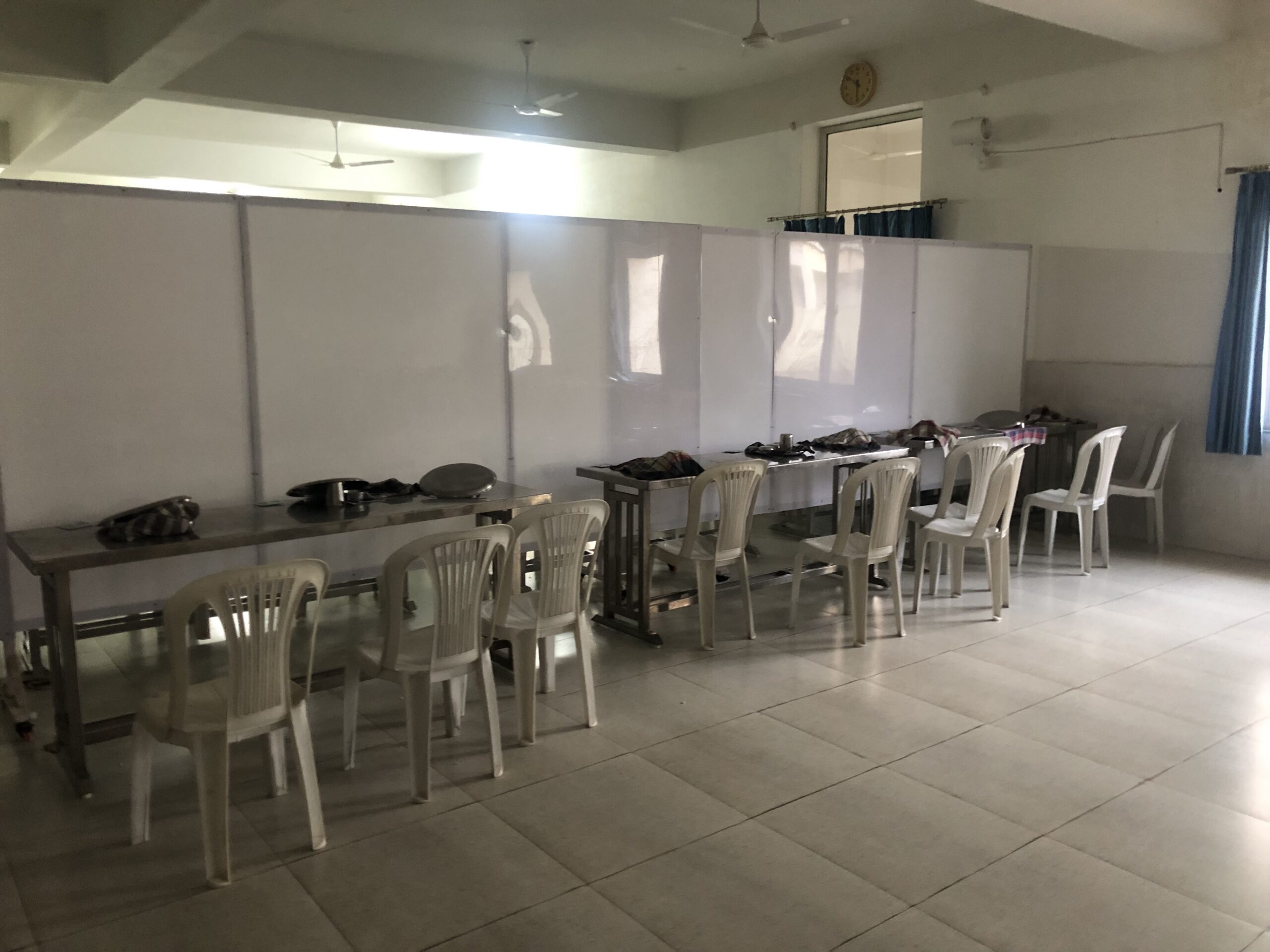
I wondered how he was and if he was coping with the basic facilities and the early mornings. I hoped he was doing well, and I even started to miss him.
We got apples at breakfast one day, and one of my mental wanderings led to the realisation that not all cultures just bite into an apple and munch it, skin and all, sans utensils. Personally, I like to grab an apple and eat it as I go for a walk, but I’ve been met by bemused stares in several countries.
I glanced around – incorporating the glance into a faux-casual stretch of the arms – to evaluate the Indian ladies’ apple-eating technique. Many were peeling them, some had sliced them into neat segments, and Parisian Louise had created what can only be described as a fanouflé with hers; it fanned out from the centre of the plate in a flower shape. I invented that word for the occasion, by the way. It should be a thing in the branch of the French language devoted to apple-eating.
MORNING PATHTIME
After breakfast, we had until 8am to play with, which meant freshening up or just diving straight back into bed to snatch back a bit of sleep that the 4am gong had stolen. It also involved pacing along the path, our only exercise.
Path-pacing became our pastime. We passed each other, eyes on the ground or straight ahead, zero eye contact. But it was hard! At first, I kept finding myself trying to make smiley eye contact with the other ladies, hoping for a complicit British eye roll as if to say Morning! Here we go again, walking along the path, just for a change! No one was game though, apart from one woman who stared at me in deep fascination for the entire 10 days, she just couldn’t help herself. I got paranoid hanging up my socks on the washing line, I could feel her judging my sock-hanging skills.
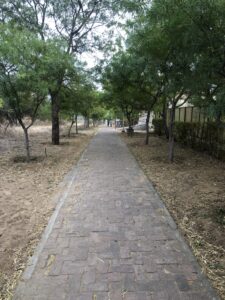
TREES, SQUADGERS & A DONKEY ENCOUNTER
When there are none of the usual distractions, it’s funny what the mind latches onto instead. While being driven round the bend by my racing thoughts, I couldn’t help but be amused by my own musings. I performed mental stand-up comedy for myself, applauding my own dad jokes and absurdity, inventing words and becoming the star of my own show.
My attention was captivated by nature. I’ve always loved trees, but now I found myself really staring at them in sheer awe. Just look at this beauty in all its mighty treeness! Doing its tree things with its leaves and branches, swaying, reaching, rustling its leaves! What a marvel! That tree isn’t overthinking its existence, wondering what to do with its life, it’s just fulfilling its purpose as a tree, growing, expanding, thriving powered by the same life force that keeps us alive.
I got swept up in the mental narration of nature in a David Attenborough voice. I spotted some squirrel-esque creatures darting about – what a spectacle! They had stripey backs, a cross between a squirrel and a badger; I named them squadgers and amused myself with the name for the duration of the course. There goes a squadger, I’d narrate, off out to get his morning berries! Turns out they’re actually Indian Palm Squirrels, but I’m sure they won’t take offence at their new nickname.
I also saw some green parroty-type birds high up in the trees. They’d have a daily squawk-off during our 5pm break. Then they’d swoop through the air in pairs, loving life. I think they were rubbing it in. I can squawk and you cannot, you crazy humans, choosing to be silent! Ha!
Once a ginger cat sauntered by when I was walking along the path. I did a double take. Twice a sandy-coloured dog found his way in and was very pleased to see everyone; the feeling was mutual. These were major events.
Another newsworthy incident occurred when I was strolling along the path, eyes cast down. I looked up and found a donkey standing at the side of the path! Our eyes met, and we shared a moment, but we didn’t take things any further.
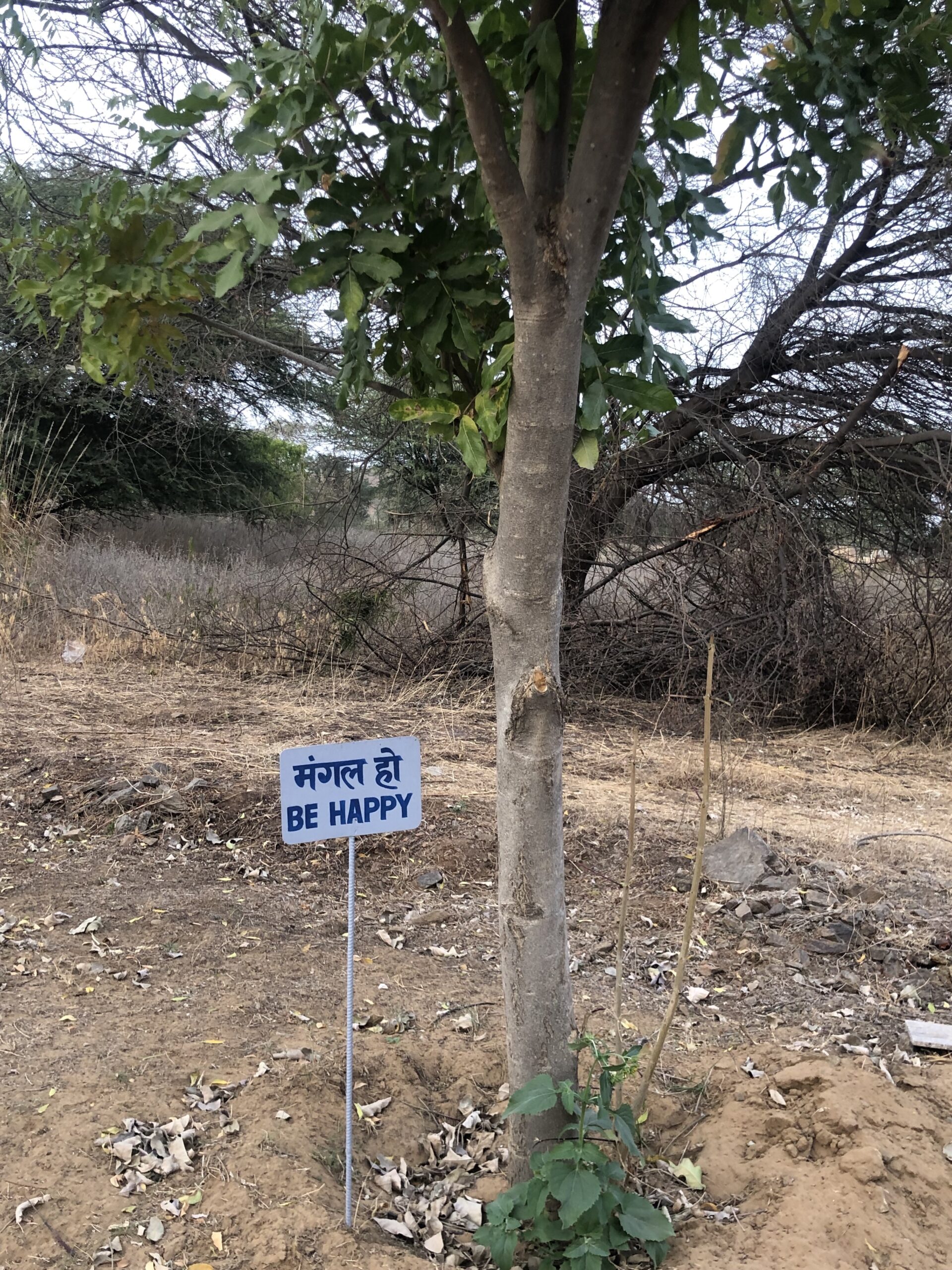
ROOM-SHARING: LOTIONS, POTIONS & OVERSLEEPING
Sharing a room with a total stranger is rather awkward, and even more so when you can’t (or shouldn’t) even communicate with gestures or eye contact. Parisian Louise, however, asked me the following in the first day of “silence”:
– Can I put the light on? It was dark, so I couldn’t even nod. Yes, I mumbled with a touch of guilt.
– Can I use your shampoo? – Yes, use anything! (oh putain, I spoke)
– Is it OK if I use the bathroom? – Vigorous nod.
I thought I’d go minimalist on the beauty stuff, so I just took shampoo, shower gel and sweet almond oil. Parisian Louise had a washbag bursting with all the crèmes magnifiques du monde. I took a sneaky peak: exfoliant, serum, rich creams, purifying masks, and all the cosmetic joys sous le soleil (but not shampoo…). I had product envy. My sweet almond oil was starting to dry out my skin, and I almost stole a dollop of her cream but realised that it would be stealing, and I’d vowed at the start not to break any of the five precepts in the code of discipline: no killing of any being (I’d already killed several mosquitoes); no stealing (damn it); no sexual activity (fat chance); no telling lies (even to myself), no intoxicants (my thoughts alone were intoxicating).
After one gruelling afternoon session in the Dhamma Hall, I came back to the room to fling myself on my bed and pass out for a while. As I walked into our bedroom, I saw Parisian Louise sat up in bed wearing a mint-green face mask, filing her nails and looking all fresh and pampered. A laugh escaped my mouth and hers at the same moment. Forbidden laughter. Like getting the giggles as a kid in church or in the library. Laughter suppression doubles the funniness of an already-funny situation.
On day 4, I slept through the almighty 4am gong. Louise was up and about and then got back into bed with the light on, and I felt her staring at me. What the fuck’s she doing up in the middle of the night, and why has she left the light on? C’est bizarre. Jet lag? I went back to sleep but woke up again as she opened the door to leave. I turned over and looked at my alarm clock that I’d forgotten to set as a backup. 4:27am. Oh double merde!
LUNCHTIME & THE PAN LID MOMENT
Lunch was an array of vegetable dishes and rice. I broke my silence a few times asking if things were gluten free, but that was preferable to vomiting my guts out in the meditation hall and pretending to remain equanimous to the sensations.
We had to line up with our plates and serve ourselves from a long table of food. I reached the large pan of rice, removed the lid and for some reason, I tucked it under my arm like it was my own personal lid, and walked on, continuing to serve myself from the subsequent pots and pans. I reached the end, and something didn’t feel right. I had a pan lid under my armpit, and I startled my fellow vipassana-ers by yelping “Oh! I’ve pinched the lid!”
Unnecessary, but that’s what happened. Silence broken because of a pan lid.
5PM CORNFLAKE MANIA
The 5pm snack was rice crispies and spicy cornflakes. We had to line up and serve ourselves from a mighty vat of cereals, but the rice crispies vastly outnumbered the cornflakes. I reckon there were about 10 cornflakes per 100 rice crispies. One day, there was an element of unrest amongst us as the queue came to a standstill. The lady at the front of the queue was taking FOREVER. What on earth was going on?! Eventually she turned round, revealing an unusually large pile of spicy cornflakes; she’d been taking her own sweet time to pick out as many spicy cornflakes as possible with the scoop. Pure craving for spicy cornflakes, pure aversion to the cereal imbalance. The pure shame of it.
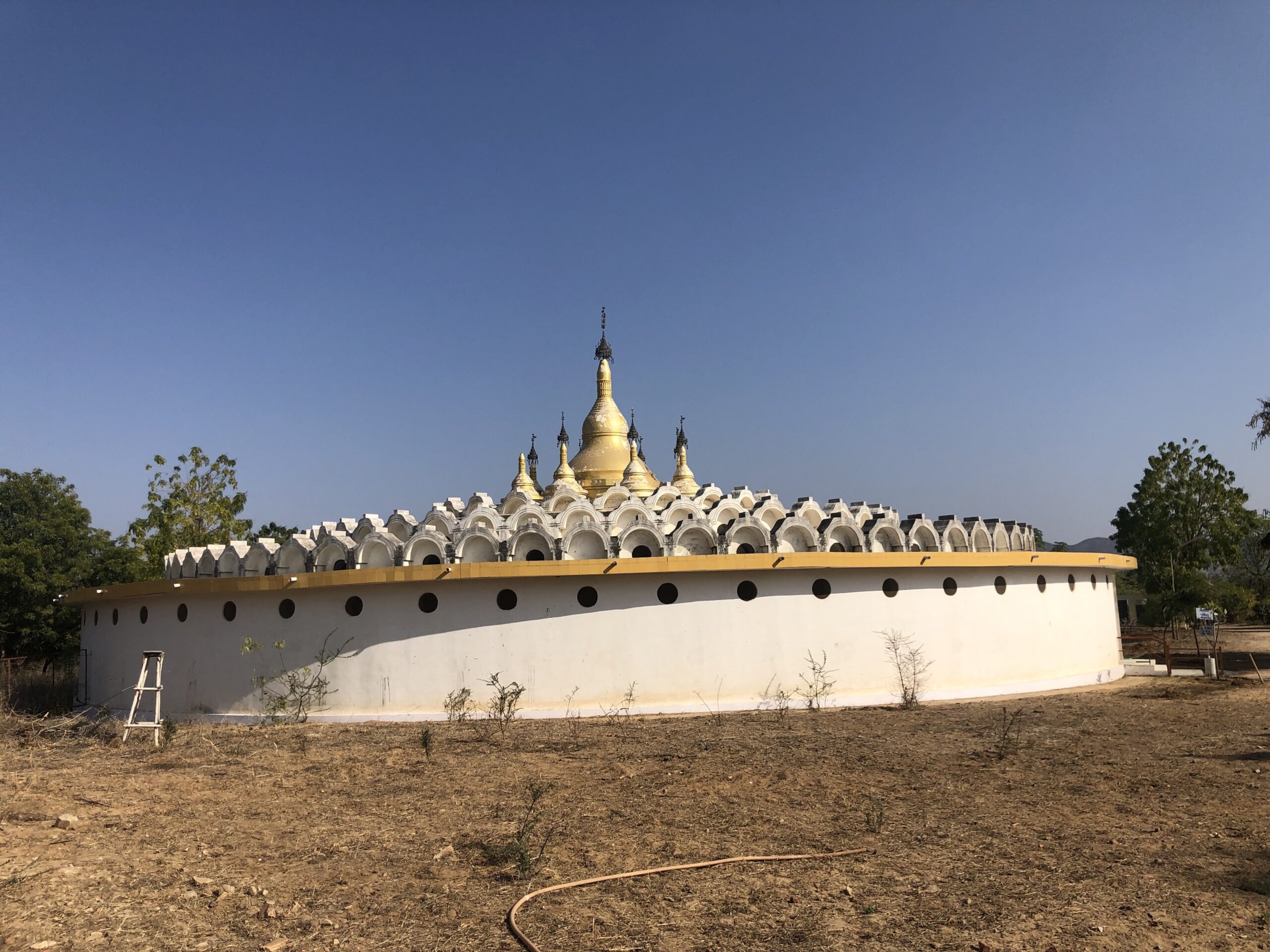
THE FIRM ANGEL
Every couple of days we had to go up to the front of the meditation hall to check in with the teacher on her platform, overlooking us vipassanees. She wanted to know if we were all right, if we had any problems with the technique. She was dressed in floaty white, her shiny grey hair in a loose bun. Radiant, angelic, and a teeny bit scary.
Louise and I, the English speakers, went up and sat before her, looking up at her like kids in primary school at reading time.
“Helen, have you done any other meditations in which you have to listen to this amount of chanting?” she asked me, her eyes bright, piercing.
“Er, no.” I croaked (thank fuck, I thought). During Goenka’s relentless chanting, I got a little bored, and in addition to listening to the temple music, I decided to focus on the energy in and around my body, on the space in the room, slowing down my brainwaves, sprinkling in a little Dispenza. I thought it could do no harm.
“Well, you might think, oh, this is boring. I’m going to try another meditation to pass the time, but let me tell you, this is not the time for that. You must put a stop to it immediately.”
She said this in a tone that somehow managed to be both firm and gentle, scary but loving.
“Okay…” I said, guiltily. But how did she know?! Fuck, she’s psychic. From then on, I started mentally calling her the Firm Angel. I got a bit paranoid that she could read my mind, though. She must have some kind of special angelic powers. When she walked, she seemed to glide through the air, radiating light and sprinkling magic dust. The Firm Angel was made of different stuff.
I put a stop to it. I knew it was an invitation to work on both presence and my aversion to the chanting. I eventually grew to appreciate it, finding the torrent of sound and vibration very soothing.
THE GREAT AFTERNOON BELCH-OFF
The afternoons were a challenge; they seemed to drag, the post-lunch farts and burps echoing through the warm air. It seems that in an Indian Vipassana, there’s no shame attached to belching out loud. Belches are released no differently to a sneeze or a cough. Some people let rip in the most sonorous of fashions, like long yodelling type burps and all form of fartage, from the shrill squeak to the rumbling, multi-part fart.
FROM ANAPANA TO VIPASSANA
On the fourth day, we got to move from nasal contemplation to the actual practice of the Vipassana technique. Remember that the word Vipassana means to see reality as it really is, not as we want it to be.
We learn about sankharas: the imprints on our subconscious left by past thoughts, emotions and actions. When we’re meditating and we feel physical discomfort, strong emotions and restlessness, these are old sankharas coming to the surface. Not reacting to these sneaky little sankharas weakens their imprints and gradually they disappear, purifying the mind for greater clarity and peace. This also means not getting all chuffed with yourself for feeling pleasant tingles or pissed off because the pins and needles in your left foot are back.
The technique involves a meticulous body scan, where you take your awareness from the crown of the head right down to the tips of your toes, via every single inch of your body, with the objective of observing every sensation along the way, and not reacting to them with our own narratives and stories. We are the observers, that’s all.
EVERY SENSATION…
At first, whole sections of my body were devoid of sensation. I’d scan my upper arms: just a big, blank void. I’d move on, and my upper arms would come online a few body parts later. A bit late to the party, Mr Upper Arm, I’d think to myself, as I was already focusing on my thigh and its respective lack of sensations. After a couple of days, something shifted. I started feeling tingles, and I felt like my whole body had become my heartbeat. Pounding, I felt like I was going to take off and land on top of the temple on the hill, but as instructed, I didn’t label it as good or bad or freak out, I just observed with curiosity. It feels like you’re performing careful surgery on yourself, using your awareness as your tool.
The same day as the all-body heartbeat, during tea break, I was chasing stubborn rice crispies around my plate with a spoon, teary-eyed, tormented by the voices in my own head, so loud in the silence. What shall I do? Since when have I thought that this amount of conflict was acceptable in a relationship? As soon as I asked these questions, I got a huge stabbing pain in my gut — almost doing a crunchy rice crispie faceplant — and with it came my answer. It was the most difficult no-brainer. I’ve been telling you this for months, my gut was saying. I’d been trying to ignore it, but Vipassana slapped me on the face with it. It was like a murky pond suddenly became crystal-clear. I saw things as they were. Vipassana.
I went back into the Dhamma Hall and continued meditating. A searing heat surged through my pulsating body, but I had to remain neutral to it, and just like that, it gradually melted away. I later learned in one of Goenka’s evening dhamma talks that this pounding heat is a sankhara of anger. I stripped through to a layer of peace after that, and the emotional rollercoaster started slowing down.
In one morning session, I heard the sound of a woman wailing loudly outside. I think she was in the residential area. Piercing, painful, chilling wails. It sounded like intense grief, brutal loss. The only thing I could think was Ohhh, sending you so much love and at that instant, warm electricity cascaded through my entire body. Compassion is something cultivated in Vipassana, and this felt like compassion on steroids.
NOBLE SILENCE ENDS
When the noble silence was lifted, I felt calm, clear, peaceful, somewhat indifferent. Equanimous, perhaps. I had enjoyed being silent, free of to-do lists and away from screens. In such a busy world, the simplicity of it all was refreshing.
The Indian ladies were bubbly, full of curiosity and questions that they’d been dying to ask me all week. What’s your job? Do you do yoga? Did you like the food? I felt close to them all because we’d just achieved something difficult all together. My first word was “Hiii!” to Louise, bursting through our room door like she did on our first evening. We chatted until 2am; we got along well and laughed at what we’d experienced during the week. We’d both found entertainment in the temple songs and bantered over which song was the best. It felt like the last day of term at school.
JUST THE START OF THE PATH
Our relationship ended very soon after this. Not exactly a shocker, that. Vipassana catalysed my exit from a relationship that made me feel icky inside. It was a lesson in self-worth and sticking by my values. And that’s another story in itself.
I’ve had two more Vipassana experiences since this Indian introduction to the Dhamma path. To me, it isn’t something to do once and tick off the bucket list, it’s an ongoing decluttering of the mind. Each Vipassana retreat is a step along the path to liberation. It’s like peeling away layers of conditioning at each sitting. What’s stayed with me is this: it’s not what happens that causes suffering — it’s our reactions, our inability to just let things go. It’s also teaching me to find the answers in the sensations, rather than jumping on the thought train and trying to figure things out in my head.
Vipassana is helping me understand the impermanence of everything that we label good or bad. When things come to an end, space opens up for new things to emerge, grow. Basically, nothing stays the same, and the only thing that’s here to stay is impermanence. One of my biggest Vipassana takeaways: stay light, stay curious, and never stray from the funny side, because that’s where the squadgers hang out – and they’ll get you through it.
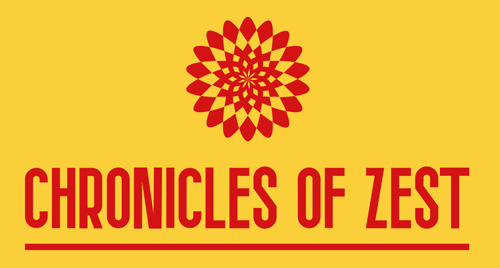
Thank you Helen 🙏 What an education, I’ve learned so much from this. The way you write keeps me hooked till the end, then longing for the next chapter….soon please!
I really need Vipassanna in my life too, that’s a fact xx
lol. It’s majorly impressive whay you have done but I reckon The Angel would give me a Firm kick up the arse and send me packing!
Can’tbleep my mind clear for a couple of minutes at the end!
Hahaha! Love it. 🙂 Thanks for reading, Michael!
I’m so happy to hear it resonated. Thank you so much for your support! Much love xxxx